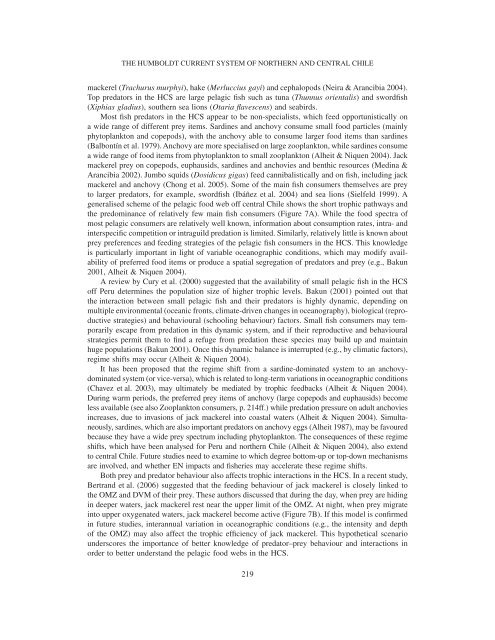the humboldt current system of northern and central chile - figema
the humboldt current system of northern and central chile - figema
the humboldt current system of northern and central chile - figema
You also want an ePaper? Increase the reach of your titles
YUMPU automatically turns print PDFs into web optimized ePapers that Google loves.
THE HUMBOLDT CURRENT SYSTEM OF NORTHERN AND CENTRAL CHILEmackerel (Trachurus murphyi), hake (Merluccius gayi) <strong>and</strong> cephalopods (Neira & Arancibia 2004).Top predators in <strong>the</strong> HCS are large pelagic fish such as tuna (Thunnus orientalis) <strong>and</strong> swordfish(Xiphias gladius), sou<strong>the</strong>rn sea lions (Otaria flavescens) <strong>and</strong> seabirds.Most fish predators in <strong>the</strong> HCS appear to be non-specialists, which feed opportunistically ona wide range <strong>of</strong> different prey items. Sardines <strong>and</strong> anchovy consume small food particles (mainlyphytoplankton <strong>and</strong> copepods), with <strong>the</strong> anchovy able to consume larger food items than sardines(Balbontín et al. 1979). Anchovy are more specialised on large zooplankton, while sardines consumea wide range <strong>of</strong> food items from phytoplankton to small zooplankton (Alheit & Niquen 2004). Jackmackerel prey on copepods, euphausids, sardines <strong>and</strong> anchovies <strong>and</strong> benthic resources (Medina &Arancibia 2002). Jumbo squids (Dosidicus gigas) feed cannibalistically <strong>and</strong> on fish, including jackmackerel <strong>and</strong> anchovy (Chong et al. 2005). Some <strong>of</strong> <strong>the</strong> main fish consumers <strong>the</strong>mselves are preyto larger predators, for example, swordfish (Ibáñez et al. 2004) <strong>and</strong> sea lions (Sielfeld 1999). Ageneralised scheme <strong>of</strong> <strong>the</strong> pelagic food web <strong>of</strong>f <strong>central</strong> Chile shows <strong>the</strong> short trophic pathways <strong>and</strong><strong>the</strong> predominance <strong>of</strong> relatively few main fish consumers (Figure 7A). While <strong>the</strong> food spectra <strong>of</strong>most pelagic consumers are relatively well known, information about consumption rates, intra- <strong>and</strong>interspecific competition or intraguild predation is limited. Similarly, relatively little is known aboutprey preferences <strong>and</strong> feeding strategies <strong>of</strong> <strong>the</strong> pelagic fish consumers in <strong>the</strong> HCS. This knowledgeis particularly important in light <strong>of</strong> variable oceanographic conditions, which may modify availability<strong>of</strong> preferred food items or produce a spatial segregation <strong>of</strong> predators <strong>and</strong> prey (e.g., Bakun2001, Alheit & Niquen 2004).A review by Cury et al. (2000) suggested that <strong>the</strong> availability <strong>of</strong> small pelagic fish in <strong>the</strong> HCS<strong>of</strong>f Peru determines <strong>the</strong> population size <strong>of</strong> higher trophic levels. Bakun (2001) pointed out that<strong>the</strong> interaction between small pelagic fish <strong>and</strong> <strong>the</strong>ir predators is highly dynamic, depending onmultiple environmental (oceanic fronts, climate-driven changes in oceanography), biological (reproductivestrategies) <strong>and</strong> behavioural (schooling behaviour) factors. Small fish consumers may temporarilyescape from predation in this dynamic <strong>system</strong>, <strong>and</strong> if <strong>the</strong>ir reproductive <strong>and</strong> behaviouralstrategies permit <strong>the</strong>m to find a refuge from predation <strong>the</strong>se species may build up <strong>and</strong> maintainhuge populations (Bakun 2001). Once this dynamic balance is interrupted (e.g., by climatic factors),regime shifts may occur (Alheit & Niquen 2004).It has been proposed that <strong>the</strong> regime shift from a sardine-dominated <strong>system</strong> to an anchovydominated<strong>system</strong> (or vice-versa), which is related to long-term variations in oceanographic conditions(Chavez et al. 2003), may ultimately be mediated by trophic feedbacks (Alheit & Niquen 2004).During warm periods, <strong>the</strong> preferred prey items <strong>of</strong> anchovy (large copepods <strong>and</strong> euphausids) becomeless available (see also Zooplankton consumers, p. 214ff.) while predation pressure on adult anchoviesincreases, due to invasions <strong>of</strong> jack mackerel into coastal waters (Alheit & Niquen 2004). Simultaneously,sardines, which are also important predators on anchovy eggs (Alheit 1987), may be favouredbecause <strong>the</strong>y have a wide prey spectrum including phytoplankton. The consequences <strong>of</strong> <strong>the</strong>se regimeshifts, which have been analysed for Peru <strong>and</strong> nor<strong>the</strong>rn Chile (Alheit & Niquen 2004), also extendto <strong>central</strong> Chile. Future studies need to examine to which degree bottom-up or top-down mechanismsare involved, <strong>and</strong> whe<strong>the</strong>r EN impacts <strong>and</strong> fisheries may accelerate <strong>the</strong>se regime shifts.Both prey <strong>and</strong> predator behaviour also affects trophic interactions in <strong>the</strong> HCS. In a recent study,Bertr<strong>and</strong> et al. (2006) suggested that <strong>the</strong> feeding behaviour <strong>of</strong> jack mackerel is closely linked to<strong>the</strong> OMZ <strong>and</strong> DVM <strong>of</strong> <strong>the</strong>ir prey. These authors discussed that during <strong>the</strong> day, when prey are hidingin deeper waters, jack mackerel rest near <strong>the</strong> upper limit <strong>of</strong> <strong>the</strong> OMZ. At night, when prey migrateinto upper oxygenated waters, jack mackerel become active (Figure 7B). If this model is confirmedin future studies, interannual variation in oceanographic conditions (e.g., <strong>the</strong> intensity <strong>and</strong> depth<strong>of</strong> <strong>the</strong> OMZ) may also affect <strong>the</strong> trophic efficiency <strong>of</strong> jack mackerel. This hypo<strong>the</strong>tical scenariounderscores <strong>the</strong> importance <strong>of</strong> better knowledge <strong>of</strong> predator–prey behaviour <strong>and</strong> interactions inorder to better underst<strong>and</strong> <strong>the</strong> pelagic food webs in <strong>the</strong> HCS.219










